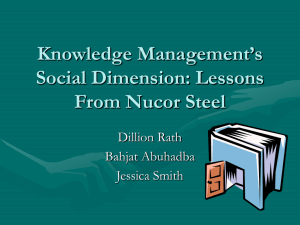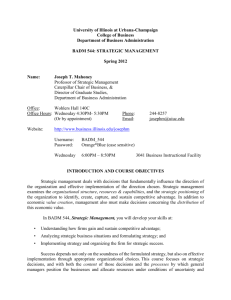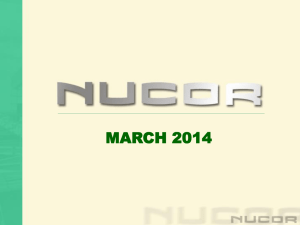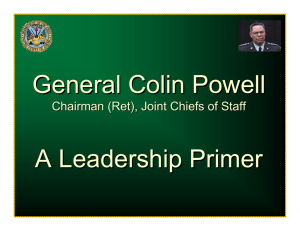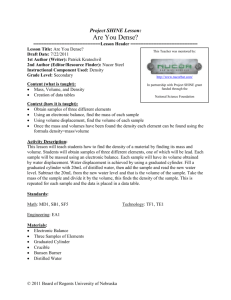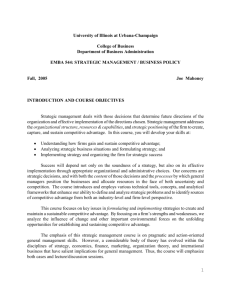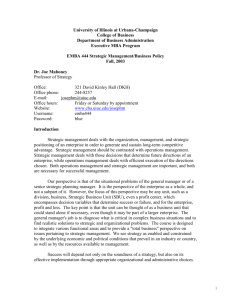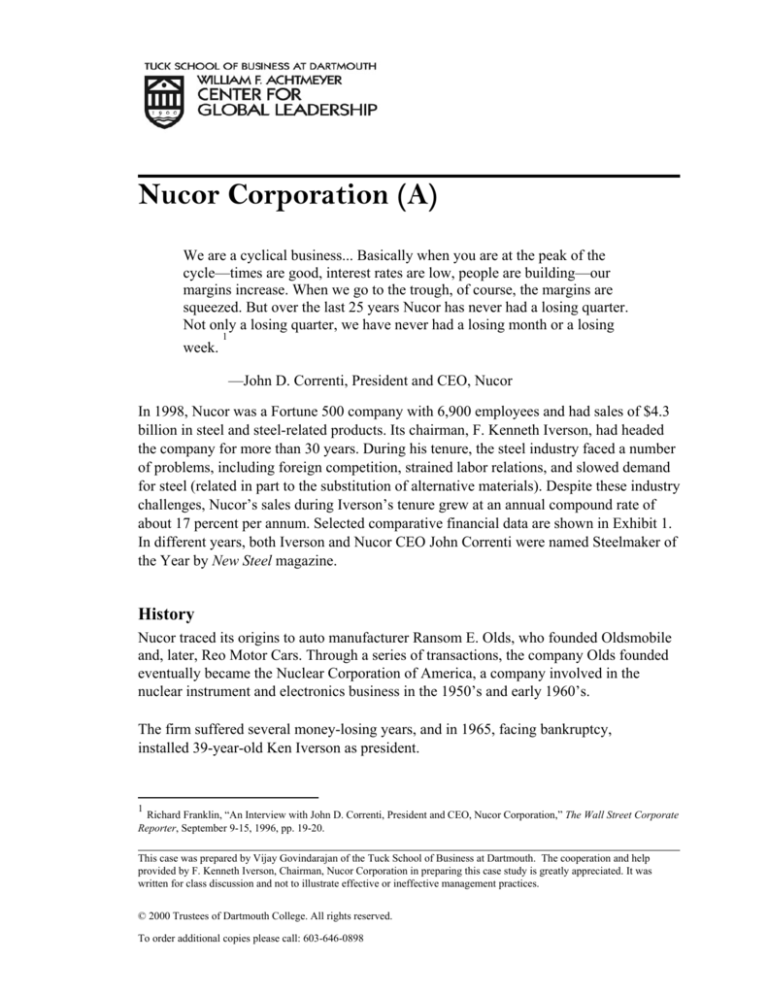
Nucor Corporation (A)
We are a cyclical business... Basically when you are at the peak of the
cycle—times are good, interest rates are low, people are building—our
margins increase. When we go to the trough, of course, the margins are
squeezed. But over the last 25 years Nucor has never had a losing quarter.
Not only a losing quarter, we have never had a losing month or a losing
1
week.
—John D. Correnti, President and CEO, Nucor
In 1998, Nucor was a Fortune 500 company with 6,900 employees and had sales of $4.3
billion in steel and steel-related products. Its chairman, F. Kenneth Iverson, had headed
the company for more than 30 years. During his tenure, the steel industry faced a number
of problems, including foreign competition, strained labor relations, and slowed demand
for steel (related in part to the substitution of alternative materials). Despite these industry
challenges, Nucor’s sales during Iverson’s tenure grew at an annual compound rate of
about 17 percent per annum. Selected comparative financial data are shown in Exhibit 1.
In different years, both Iverson and Nucor CEO John Correnti were named Steelmaker of
the Year by New Steel magazine.
History
Nucor traced its origins to auto manufacturer Ransom E. Olds, who founded Oldsmobile
and, later, Reo Motor Cars. Through a series of transactions, the company Olds founded
eventually became the Nuclear Corporation of America, a company involved in the
nuclear instrument and electronics business in the 1950’s and early 1960’s.
The firm suffered several money-losing years, and in 1965, facing bankruptcy,
installed 39-year-old Ken Iverson as president.
1
Richard Franklin, “An Interview with John D. Correnti, President and CEO, Nucor Corporation,” The Wall Street Corporate
Reporter, September 9-15, 1996, pp. 19-20.
This case was prepared by Vijay Govindarajan of the Tuck School of Business at Dartmouth. The cooperation and help
provided by F. Kenneth Iverson, Chairman, Nucor Corporation in preparing this case study is greatly appreciated. It was
written for class discussion and not to illustrate effective or ineffective management practices.
© 2000 Trustees of Dartmouth College. All rights reserved.
To order additional copies please call: 603-646-0898
Nucor Corporation (A)
no. 2-0015
Iverson had a bachelor’s degree in aeronautical engineering from Cornell and a
master’s degree in mechanical engineering from Purdue. He began his professional
career as a research physicist and held several technical and management positions in
the metals industry. He joined Nuclear Corporation of America as a vice president in
1962 and was appointed president three years later.
Iverson focused the failing company on two businesses: making steel from recycled
scrap metal and fabricating steel joists for use in nonresidential construction. In
1972, the firm changed its name to Nucor Corporation. By 1998, it had become
America’s second-largest steel maker.
Operations
Nucor located its diverse facilities in rural areas across the United States, establishing
strong ties to its local communities and its work force. As a leading employer with the
ability to pay top wages, it attracted hard-working, dedicated employees. These factors
also allowed Nucor to select from among competing locales, sitting its operations in
states with tax structures that encouraged business growth and regulatory policies that
favored the company’s commitment to remaining union-free. By 1998 Nucor and its
subsidiaries consisted of nine businesses, with 25 plants. These businesses included the
following:
Nucor Steel
Products: steel sheet, bars, angles, light structural carbon and alloy steels.
Plants: Darlington, S.C; Norfolk, Nebr.; Jewett, Tex.; Plymouth, Utah; Crawfordsville,
Ind.; Hickman, Ark.; Mt. Pleasant, S.C.
Nucor-Yamato Steel Company
Products: wide-flange steel beams, pilings, heavy structural steel products.
Plant: Blytheville, Ark.
Vulcraft
Products: steel joists, joist girders and steel deck for building construction.
Plants: Florence, S.C.; Norfolk, Nebr.; Fort Payne, Ala.; Grapeland, Tex.;
Saint Joe, Ind.; Brigham City, Utah
Tuck School of Business at Dartmouth – William F. Achtmeyer Center for Global Leadership
2
Nucor Corporation (A)
no. 2-0015
Nucor Cold Finish
Products: cold-finished steel products for shafting, precision machined parts.
Plants: Norfolk, Nebr.; Darlington, S.C.; Brigham City, Utah.
Nucor Fastener
Products: standard steel hexhead cap screws, hex bolts, socket head cap screws.
Plants: Saint Joe, Ind.; Conway, Ark.
Nucor Bearing Products, Inc.
Products: unground and semi-ground automotive steel bearings, machined steel parts.
Plant: Wilson, N.C.
Nucor Building Systems
Products: metal buildings, metal building components.
Plants: Waterloo, Ind.; Swansea, S.C.
Nucor Grinding Balls
Products: steel grinding balls, used by the mining industry to process ores.
Plant: Brigham City, Utah.
Nucor Wire
Products: stainless steel wire.
Plant: Lancaster, S.C.
Strategy
Nucor’s strategy focused on two major competencies: building steel manufacturing
facilities economically and operating them productively. The company’s hallmarks
were continuous innovation, modern equipment, individualized customer service, and
a commitment to producing high-quality steel and steel products at competitive prices.
Nucor was the first in the industry to adopt a number of new products and innovative
processes, including thin-slab cast steel, iron carbide, and the direct casting of stainless
wire.
Tuck School of Business at Dartmouth – William F. Achtmeyer Center for Global Leadership
3
Nucor Corporation (A)
no. 2-0015
In 1998 Nucor produced a greater variety of steel products than did any other steel
company in the United States—both low-end (non-flat) steel, such as reinforcing bar,
and high-end (flat) steel, including motor lamination steel used in dishwashers,
washers, and dryers, as well as stainless steel used in automotive catalytic converters
and exhaust systems.
Nucor’s major customer segments were the construction industry (60 percent), the
automotive and appliance industries, (15 percent), and the oil and gas industries (15
percent), with the remaining 10 percent divided among miscellaneous users. All the
company’s low-end steel products (50 percent of its total output) were distributed
through steel service centers. Its high-end products (the other 50 percent) were sold
directly to original equipment manufacturers (OEMs), fabricators, or end-use
customers.
Nucor’s ratio of debt to total capital was not allowed to exceed 30 percent. In 1997
that ratio was 7 percent. The company did not believe in acquisitions or mergers,
choosing instead to commit to internally generated growth. It had no plans to
diversify beyond steel and steel-related products.
Organization Structure
Compared to the typical Fortune 500 company with 10 or more management layers,
Nucor’s structure was decentralized, with only the four management layers, illustrated
below:
Chairman / Vice Chairman / President
Vice President / Plant General Manager
Department Manager
Supervisor
“We have a very flat organization structure,” said president and CEO John Correnti.
“The standard joke in the company is if you are a janitor and you get five promotions,
you have Correnti’s job. If you take a typical organization chart, it is the typical
pyramid. You take our company, you turn the pyramid upside down; 6,800 people do
not work for me, I work for 6,800 people.”2
2
Richard Franklin, “An Interview with John D. Correnti, President and CEO, Nucor Corporation,” The
Wall Street Corporate Reporter, September 9-15, 1996, p. 20.
Tuck School of Business at Dartmouth – William F. Achtmeyer Center for Global Leadership
4
Nucor Corporation (A)
no. 2-0015
In 1998 Nucor’s Board of Directors had only six members: the current chairman,
president, and chief financial officer, and three retired Nucor executives. Only 22
employees (including clerical staff) worked at the corporate head office, which was
located in an unassuming office building across the street from a shopping mall. All other
employees worked in one of the company’s 25 plants, each of which employed, on
average, between 250 and 300 people.
The general manager at each plant was granted considerable autonomy, essentially
operating the facility as an independent business. Each plant could source its inputs either
from another Nucor plant or from the outside market. With the day-to-day decisions
being made on site and the lines of communication to employees kept open and informal,
problems could be solved quickly without having to wait for decisions from headquarters.
“We are honest-to-God autonomous,” said the general manager of one plant. “That means
that we duplicate efforts made in other parts of Nucor. The company might develop the
same computer program six times. But the advantages of local autonomy are so great, we
think it is worth it.”3 One such advantage, noted Iverson, was greater operating
efficiency. “None of our divisions are in the same town as our Charlotte, North Carolina
headquarters,” he said. “If any of them were, U.S. headquarters types would always be
over there making suggestions and wasting their time with our opinions. A general
manager running a division in Charlotte would feel like he was living with his mother-inlaw.”4
Other remarks by Iverson provided insight into the company’s tolerance for experimentation and willingness to take risks: “We try to impress on our employees that we are
not King Solomon. We use an expression that I really like: ‘Good managers make bad
decisions.’ We believe that if you take an average person and put him in a management
position, he’ll make 50 percent good decisions and 50 percent bad decisions. A good
manager makes 60 percent good decisions. That means 40 percent of those decisions
could have been better. We continually tell our employees that it is their responsibility to
the company to let the managers know when they make those 40 percent decisions that
could have been better. . . .The only other point I’d like to make about decision making
is, don’t keep making the same bad decisions.”5
In a 1998 interview, Iverson said that “management can’t be effective without taking
some amount of risk. A group of us were just recently thinking about the pluses and
minuses of sinking millions of dollars into a new process for pickling steel, removing all
the rust before finishing it. Right now, that’s done by using acid. But maybe it can be
3
Ken Iverson, Plain Talk. John Wiley & Sons, Inc., 1998, p. 27.
Ibid, p. 37
5
F. Kenneth Iverson, “Effective Leadership: The key is simplicity,” in Y.K. Shetty and V.M. Buchler, eds., The Quest for
Competitiveness (New York: Quorum Books, 1991), p. 287. Quoted in Pankaj Ghemawat and Henrions J. Stander, “Nucor at
Crossroads,” Harvard Business School, pp. 8-9.
4
Tuck School of Business at Dartmouth – William F. Achtmeyer Center for Global Leadership
5
Nucor Corporation (A)
no. 2-0015
done better, faster, cheaper electrolytically…I can’t stand it when there are not strange
ideas (like this one) floating around the company.”6
Human Resource Policies
Nucor was very selective in recruiting employees and was able to choose from a large
applicant pool. Noted Iverson, “Darlington [S.C.] needed eight people, and we put a
little ad in the county weekly newspaper that said, `Nucor Steel will take some
applications on Saturday morning at 8:30 for new employees.’ When we went out there
for the interviewing, there were 1,200 people lined up in that plant. We couldn’t even
get into the plant to get to the personnel department….Finally we called the state police
and said, `You’ve got to do something. We’ve got a traffic jam out here.’ And the cop
on duty said, ‘We can’t do it, because we’ve got three people out there applying for jobs
ourselves!’”7
Employee relations at Nucor were based on four principles:
1. Management is obligated to manage Nucor in such a way that employees will
have the opportunity to earn according to their productivity.
2. Employees should feel confident that if they do their jobs properly, they will have
a job tomorrow.
3. Employees have the right to be treated fairly.
4. Employees must have an avenue of appeal when they believe they are being
treated unfairly.
As part of its commitment to fairness, Nucor had a grievance procedure that allowed any
employee to ask for a review of a grievance if he or she felt the supervisor had not
provided a fair hearing. The grievance could move up to the general manager level, and,
if the employee was still not satisfied, could be submitted to headquarters management
for final appeal.
General Managers were required to hold annual dinners with every employee, meeting
with groups of 25 to 100 at a time. These meetings gave employees a chance to discuss
problems relating to scheduling, equipment, organization, and production.
The ground rules were simple: all comments were to be business related and not involve
personalities, and all criticism was to be taken under advisement by management for
decisive action. Like traditional New England town meetings, the format was free and
6
“The Art of Keeping Management Simple,” An Interview with Ken Iversen, Harvard Management
Update, May 1998, p.7.
7
Ibid, p. 42.
Tuck School of Business at Dartmouth – William F. Achtmeyer Center for Global Leadership
6
Nucor Corporation (A)
no. 2-0015
open. Topics varied widely from year to year, and sometimes the sessions lasted well
beyond midnight.
Another key aspect of Nucor’s relationship with its workers was its commitment not to
lay off or furlough employees in periods when business was down. Instead of reducing
the work force during recessionary periods (as was the usual industry practice), Nucor
would reduce the work week. A former employee of an integrated steel company said,
“At Nucor, the cold-mill manager says that almost all of the improvements have come
from operators and operating supervisors. At my plant, operators are reluctant to
suggest improvements for fear of reducing or eliminating another worker’s job.”8
Nucor’s labor force was not unionized. An employee at Nucor Steel in Hickman, AR,
presented the majority view: “Why is Nucor nonunion? I see two main reasons. First,
it’s just not needed. Nucor takes very good care of its employees. Its pay and benefits
package is top-notch. No one has been capriciously fired. There are no layoffs. Nucor
listens to its employees through monthly crew meetings, annual dinners, and employee
surveys. We just don’t need union mediators . . . . The second reason is that we all
work together. We don’t need divisiveness. We don’t need adversaries. We can talk
among ourselves and work out our own problems.”9 Iverson noted the effectiveness of
this approach: “People like to work here. For example, the last time we had a union
organizer in Darlington, we had to send management out to protect the union guy
passing out the pamphlets.”10
Compensation
Nucor provided employees with a performance-related compensation system. All
employees were covered under one of four basic compensation plans, each featuring
incentives related to meeting specific goals and targets.
1. Production Incentive Plan. Under this plan, employees directly involved in
manufacturing were paid weekly bonuses based on actual output in relation to
anticipated production tonnages produced. The bonuses were paid only for work that
met quality standards and were pegged to work groups, rather than individual output.
(Each work group contained 25 to 40 workers.) Once the standard output was
determined, it was not revised unless there was a significant change in the way a
production process was performed due to a source other than the workers in the bonus
group. Bonuses were tied to attendance and tardiness standards. If one worker’s
tardiness or attendance problems caused the group to miss its weekly output target,
every member of the group was denied a bonus for that week. “This bonus system is
very tough,” said Iverson. “If you are late, even only five minutes, you lose your bonus
for the day. If you are thirty minutes late or you are absent for sickness or anything
8
Anthony Edwards, “How Efficient Are Our Work Practices,” New Steel, July 1996, p. 31.
Claude Riggin, “Freedom and a Hell of a Lot More at Nucor,” Newsfront column, New Steel, July 1996.
10
“Steel Man Ken Iverson,” Inc, April 1986, pp. 41-42.
9
Tuck School of Business at Dartmouth – William F. Achtmeyer Center for Global Leadership
7
Nucor Corporation (A)
no. 2-0015
else, you lose your bonus for the week. Now, we have four forgiveness days per year
when you might need to close on a house or your wife is having a baby, but only
four.”11
Maintenance personnel were assigned to each shift, and they participated in the bonus
along with the other members operating on that shift; no bonus was paid if equipment
was not operating. Production supervisors were also a part of the bonus group and
received the same bonus as the employees they supervised. Weekly output by, and
bonus for, each work group were displayed at the front entrance to the factory. While
there were no upper caps, the production incentive bonus, in general, averaged 80150% of the base wage.
Iverson gave an example of how this plan worked: “In the steel mills, there are nine
bonus groups: three in melting and casting, three in rolling, and three in finishing and
shipping. Take melting and coating, for example. We start with a base of 12 tons of
good billets per hour: above that, the people in the group get a 4% bonus for every ton
per hour. So if they have a week in which they run, say, 32 tons per hour—and that
would be low—that’s an 80% bonus. Take the regular pay, the overtime pay,
everything, multiply it by an additional 80%—and we give them that check along with
their regular check the next week."12
2. Department Manager Incentive Plan. Nucor’s department managers oversaw the
production supervisors and, in turn, reported directly to the general manager of their
plant. They earned an annual incentive bonus based on the performance of the entire
plant to which they belonged. The targeted performance criterion here was return on
assets. Every plant operated as a stand-alone business unit. All the plants had the same
performance target: a return of 25% or better on the assets employed within that plant.
In recent years, these bonuses averaged 82% of base salary.
3. Non-Production and Non-Department Manager Incentive Plan. All employees not
on the Production Incentive Plan or the Department Manager Incentive Plan—including
accountants, engineers, secretaries, clerks, and receptionists—received a bonus based
primarily upon each plant’s return on assets. It could total over 25 % of an employee’s
base salary. Every month each plant received a chart showing its return on assets on a
year-to-date basis. This chart was posted in the employee cafeteria or break area
together with another chart that showed the bonus payout; this kept employees
appraised of their expected bonus levels throughout the year.
4. Senior Officers Incentive Plan. The designation “senior officers” included all
corporate executives and plant general managers. Nucor senior officers did not have
employment contracts, nor did they participate in any profit sharing, pension, or
11
12
Ibid, pp. 44-45.
Ibid, pp. 44-45.
Tuck School of Business at Dartmouth – William F. Achtmeyer Center for Global Leadership
8
Nucor Corporation (A)
no. 2-0015
retirement plans. Their base salaries were lower than those received by executives in
comparable companies. Senior officers had only one incentive compensation system,
based upon Nucor’s return on stockholders’ equity above certain minimum earnings. A
portion of pre-tax earnings was placed into a pool that was divided among the officers.
If Nucor did well, the officers’ bonuses, in the form of stock (about 60%) and cash
(about 40%), could amount to several times base salary. If Nucor did poorly, an
officer’s compensation was only base salary and, therefore, significantly below the
average pay for this level of responsibility.
During a slack period in the 1980’s, Iverson was named the Fortune 500 CEO with the
lowest compensation. He saw this as an honor. “When I walked through a plant during
that period of time when we had to cut back to a four-day work week, or even threeand-a-half days, I never heard an employee who complained,” he said. “His pay may
have been cut 25%, but he knew that his department head was cut even more and that
the officers were cut, percentage-wise, even more than that. I call it our ‘share-the-pain’
program. . . .I think in 1980 I earned $430,000. In 1982, I earned $108,000.
Management should take the biggest drop in pay because they have the most
responsibility.”13
Information Systems
Every week each plant sent data to headquarters on the following six operations-related
variables: bids, orders, production, backlog, inventory, and shipments. Taken together,
these numbers provided a snapshot of the plant’s basic operations. The figures for all 25
plants were pulled together onto one 8.5” x 11” sheet of paper. Each plant also submitted
a second weekly report comparing the numbers on the six variables for the current week
with those for the previous week and the numbers for the most recent 13-week period
with those for the corresponding period in the previous year. This second group of data
from all 25 plants was compiled in a four-page report. Thus, all weekly data for the 25
plants were pulled together onto just five sheets of paper for corporate review.
Each plant also submitted a monthly report comparing actual to budgeted figures for
sales revenue, costs, contribution, and return on assets employed.
Iverson made the following observations regarding the design of Nucor’s information
systems: “We don’t look over the shoulders of our general managers and we don’t ask
them to submit voluminous reports explaining their actions. But that doesn’t mean we
are not paying attention. Delegation without information is suicide . . . . In short, while
we work hard to get the information we need, we’ve worked just as hard to keep our
reports streamlined and ourselves free of ‘information overload.’ A lot of managers
seem to miss the link between information overload and their compulsion to overcontrol
their operations. But the connection is really obvious. Too much information puts you in
13
Ibid, p. 44.
Tuck School of Business at Dartmouth – William F. Achtmeyer Center for Global Leadership
9
Nucor Corporation (A)
no. 2-0015
the same position as too little information—you don’t know what’s going on. And when
you don’t know what’s going on, it is hard to stay out of your people’s hair. It’s hard to
tell them ‘trust your instincts,’ and really mean it.”14
All the plant general managers met as a group with headquarters management three
times a year—in February, May, and November—to review each plant’s performance
and to plan for the months and years ahead. In addition, detailed performance data on
each plant were distributed to all plant managers on a regular basis. Plant general
managers and machine operators also commonly visited each other's mills.
Benefits
Nucor took an egalitarian approach toward employee benefits. Senior executives did
not enjoy such traditional perquisites as company cars, corporate jets, executive dining
rooms, or executive parking places. “Our corporate dining room is the deli across the
street,” remarked Iverson.15 All employees traveled in economy class, including Ken
Iverson. Certain benefits, such as Nucor’s profit-sharing and scholarship programs, its
employee stock purchase plan, and its service awards, were not available to Nucor’s
officers. All employees had the same holidays, vacation schedules, and insurance
programs, and all, including the CEO, wore the same green hard hats. (In a typical
manufacturing company, people wore different colored hats in accordance with status
or seniority, and the CEO’s often was gold-plated!) Every Nucor annual report
contained the names of every employee listed alphabetically on the front cover.
The Company maintained a profit-sharing plan for employees below the officer level,
contributing a minimum of 10% of Nucor’s pre-tax earnings each year. Of this amount,
approximately 15 to 20% was paid out to employees in March of the following year as
cash profit sharing. The remainder was placed in trust and allocated to employees based
upon their earnings as a percentage of the total earnings paid throughout Nucor. The
employees themselves made no contributions to this plan. They became fully vested
after seven full years of service and received payment when they retired or terminated
employment with Nucor. In the 1990’s, a number of employees had over $300,000 in
the trust.
Nucor had a monthly stock purchase plan featuring a 10% Nucor matching contribution,
and a 401(k) retirement savings plan that included a matching contribution of 5 to 25 %
of the employee’s contribution based on Nucor’s return on shareholders’ equity.
Additionally, employees received five shares of Nucor common stock for each five years
of continuous service as well as standard medical, dental, disability, and life insurance
coverage and standard vacation and holiday packages.
Nucor’s benefit program also attested to the company's commitment to education. Onthejob training was a matter of policy, with employees being taught to perform multiple
14
15
Ken Iverson. Plain Talk. John Wiley & Sons, Inc., 1998, pp. 37-39.
Ibid, p. 59.
Tuck School of Business at Dartmouth – William F. Achtmeyer Center for Global Leadership
10
Nucor Corporation (A)
no. 2-0015
functions. The Nucor Scholarship Fund provided awards of up to $2,200 a year for up to
four years to employees’ children who pursued higher education or vocational training
past high school. In 1996, the plan covered more than 600 students attending some 200
different learning institutions. According to Correnti, these scholarships cost Nucor about
$1.3 million a year but created a priceless reservoir of good will. “This gets Nucor around
the dinner table at night,” he said. “It creates loyalty among our employees . . . . Our
turnover is so minuscule we do not even measure it.”16
Nucor encouraged employees to recruit their friends and relatives to work for the
company. As an industry observer remarked, "In fact, for existing employees,
Nucor often means Nephews, Uncles, Cousins, and Other Relatives."17
Technology
Nucor did not have a formal R&D department, a corporate engineering group, or a chief technology
officer. Instead, it relied on equipment suppliers and other companies to do the R&D and
they adopted the technological advancements they developed—whether in steel or iron
making, or in fabrication. Teams composed of managers, engineers, and machine
operators decided what technology to adopt.
Integrated steel companies produced steel from iron ore using blast furnaces. Nucor
successfully adopted the “mini-mill” concept—first developed in Europe and Japan—in
the plant it built in Darlington, S.C., in 1969. Unlike integrated steel companies, minimills did not start with iron ore; instead, they converted scrap steel into finished steel
using small-scale electric furnaces. Nucor purchased its scrap requirements from thirdparty agents at open market prices. For the non-flat, commodity segment of the steel
industry (reinforcing bar for construction and rods for pipe, rail, and screws), mini-mills
had a cost advantage over integrated steel producers, eventually driving the latter out of
the low end of the steel industry.
Until the mid-1980’s, however, mini-mills could not produce the flat steel products
required by automotive and appliance customers, and this high-end market was
monopolized by the integrated steel producers. Then, in 1987, Nucor made history by
building the first mini-mill that could make flat steel (in Crawfordsville, I.N.) thus
gaining entry into the premium segment of the steel industry.
At its Crawfordsville facility, Nucor gambled on the thin-slab casting technology
developed by SMS Schloemann-Siemag, a West German company. Staff engineers from
more than 100 steel companies visited SMS to explore this technology, which had been
demonstrated in a small pilot but not yet proven commercially. But Nucor adopted the
16
Richard Franklin, “An Interview with John D. Correnti,” The Wall Street Corporate Reporter, September
9-15, 1996, p. 19.
17
Joseph A. Maciariello, Lasting Value, New York, NY: John Wiley & Sons, Inc., 2000, pp. 140-141.
Tuck School of Business at Dartmouth – William F. Achtmeyer Center for Global Leadership
11
Nucor Corporation (A)
no. 2-0015
process first, obtaining the rights from SMS by signing a nonexclusive contract with an
additional technology flow-back clause. Nucor’s investment in the Crawfordsville plant
represented approximately five times the company’s 1987 net earnings and virtually
equaled the stockholders’ total equity in the company that year!
By 1997 Nucor had built two more mini-mills (in Hickman, A.R., and Charleston,
S.C.), both using the thin-slab casting process to produce flat-rolled sheet steel. The
first competitive facility to make thin-slab-cast flat-rolled steel did not appear until
1995—eight years after Nucor’s pioneering effort.
In 1987 Nucor’s pursuit of technical excellence had led to the establishment of NucorYamato Steel Company, a facility jointly owned by Nucor and Yamato Kogyo of
Japan, which operated a structural steel mill in the United States that used its own
continuous-casting technology.
Several years later, Nucor became concerned that the mini-mill start-ups by several other
companies would significantly increase in the price of scrap steel or even cause scrap to
become wholly unavailable. To guard against that possibility, the company established a
plant in Trinidad, West Indies, in 1994. This plant successfully adopted a commercially
unproven technology to make iron carbide, a substitute for scrap steel, which it supplied
to the flat-rolled plant in Crawfordsville. However, in 1998 Nucor concluded that the iron
carbide supplied by the Trinidad facility was uneconomical and closed the facility.
In addition to developing new plants, Nucor was committed to continuously modernizing
its existing ones. Its philosophy was to build or rebuild at least one mill every year, in the
latter case rebuilding entirely rather than just “put(ting) new pipes in parts of the old
mill.” In building new plants or rebuilding existing plants, the company did not rely on
outside contractors, but instead handed the responsibility for design and construction
management to a small group of engineers selected from existing Nucor facilities. For
example, when it decided to add a second rolling mill at Nucor-Yamato in Blytheville,
AR, it assigned the meltshop supervisor in the first mill to coordinate the design and
construction of the meltshop in the second mill. As Greg Mathis, this meltshop
supervisor, observed, “They put it all on my shoulders—the planning, the engineering,
the contracting, the budgets . . . . I mean, we are talking about an investment of millions
of dollars and I was accountable for all of it. It worked out fine . . . because my team and
I knew what not to do from our experience running the meltshop on the first line.”18
Further, the actual construction of the plant was done by workers from the local area,
who were aware that they would subsequently be recruited to operate the mills as well.
Iverson explained the rationale behind this approach to technology management: “We
accept that roughly half of our investments in new ideas and new technologies will yield
18
Ibid, pp. 89-90.
Tuck School of Business at Dartmouth – William F. Achtmeyer Center for Global Leadership
12
Nucor Corporation (A)
no. 2-0015
no usable results . . . . Every Nucor plant has its little storehouse of equipment that was
bought, tried, and discarded. The knowledge we gather from our so-called ‘failures’ may
lead us to spectacular success . . . . We let employees invest in technology. People in the
mills identify and select most of the technology. Technology is advancing too quickly on
too many fronts. No small group of executives can possibly keep fully informed.”19
In 1991 President Bush awarded Iverson the National Medal of Technology,
America’s highest award for technological achievement and innovation.
Future
For Iverson, the national medal was not a culmination but a signpost along the way. “Our
biggest challenge (in the future) is to continue to grow the company at 15-20% per year,
and to keep earnings parallel with this growth. Business is like a flower: you either grow
or die.”20
Discussion Questions
1. Why has Nucor performed so well?
a. Is Nucor’s industry the answer?
b. Is it the “mini-mill” effect?
c. Is it market power (scale economies)?
d. Is it a distribution channel advantage?
e. Is it a raw material advantage?
f. Is it a technology advantage?
g. Is it a location advantage?
h. Is it the result of an entrenched brand name?
i. Is it Nucor’s choice of a unique strategy?
j. Is it Nucor’s ability to execute its strategy?
2. What are the most important aspects of Nucor’s overall approach to organization
and control that help explain why this company is so successful? How well do
Nucor’s organization and control mechanisms fit the company’s strategic
requirements?
3. A crucial element of Nucor’s success is its ability to mobilize two types of
knowledge: plant construction and start-up know-how; and manufacturing process
19
Ibid, pp. 5, 96, 150.
“The Art of Keeping Management Simple,” An Interview with Ken Iversen, Harvard Management
Update, May 1998, page 7.
20
Tuck School of Business at Dartmouth – William F. Achtmeyer Center for Global Leadership
13
Nucor Corporation (A)
no. 2-0015
know-how. What mechanisms does Nucor employ to manage knowledge
effectively?
1. What mechanisms help the company accumulate these two types of
knowledge in individual plants?
2. What mechanisms exist within the company to facilitate sharing this
knowledge among its 25 plants?
3. How does Nucor transfer knowledge to a greenfield, start-up operation?
4. Nucor has repeatedly demonstrated the ability to be a successful first mover in the
adoption of new technology. How does the company’s approach to organization
and control contribute to this first-mover advantage?
5. Would you like to work for Nucor?
6. Why have competitors not been able to imitate Nucor’s performance so far?
Tuck School of Business at Dartmouth – William F. Achtmeyer Center for Global Leadership
14
Nucor Corporation (A)
no. 2-0015
Exhibit 1
Selected Financial Data (1993-1997)
Return on
Sales
Equity (5($ in billions) year average)
Debt/Capital
%
5-year
Sales
Growth %
Profit
Margin
%
1997
1993-1997
1997
1993-1997
1997
Nucor
$4.1
18%
7%
23%
8%
Texas Industries*
(parent of
Chaparral Steel)
National Steel**
USX-US Steel**
$1.0
12%
22%
12%
8%
$3.1
$6.8
7%
10%
27%
21%
6%
7%
7%
6%
Bethlehem Steel**
$4.7
Deficit
28%
3%
Deficit
LTV**
$4.3
11%
18%
3%
1%
Northwester Steel*
$0.6
2%
71%
7%
Deficit
Industry Median
$1.9
10%
30%
8%
3%
*Mini-mill.
**Integrated steel producer.
Source: Forbes, January 12, 1998, pp. 196-197.
Tuck School of Business at Dartmouth – William F. Achtmeyer Center for Global Leadership
15

